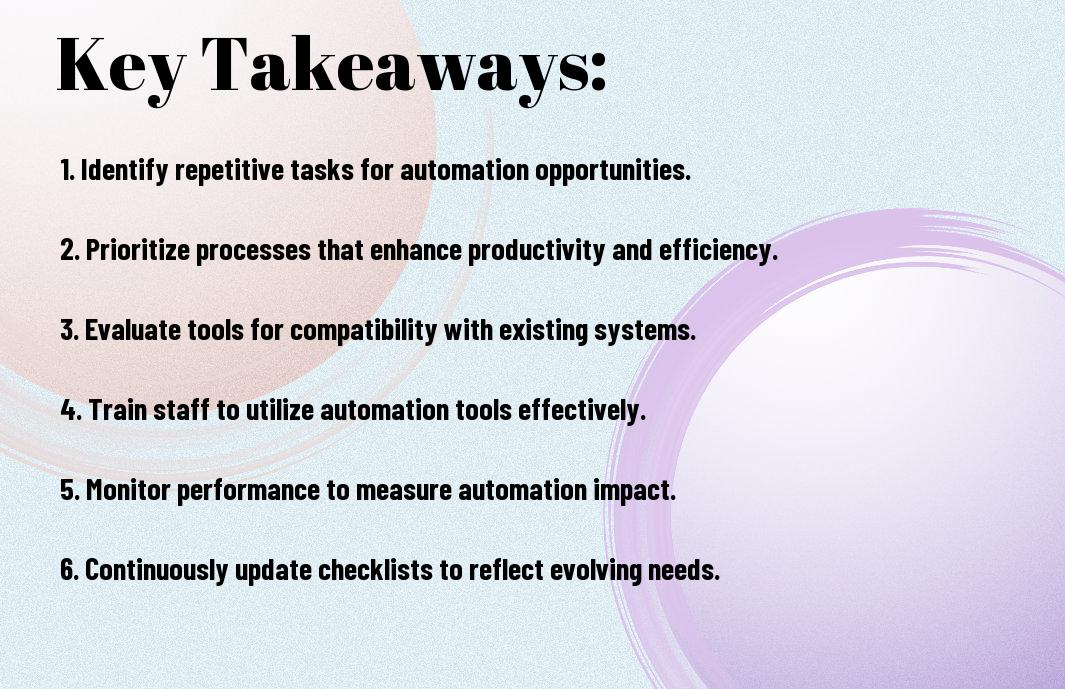Many professionals in the business world are turning to automation to streamline operations and improve efficiency. If you’re looking to enhance your workflow and maximize productivity, having a structured approach is vital. In this post, you’ll find 11 imperative checklists designed to guide you through the process of automating various aspects of your business. Each checklist focuses on key areas where automation can make a significant impact, helping you to implement effective strategies tailored to your needs.

Key Takeaways:
- Utilizing checklists streamlines the automation process, ensuring that no step is overlooked.
- Each checklist is tailored to specific areas of business automation, such as marketing, sales, and customer service.
- Automation can lead to significant time savings and increased efficiency when implemented correctly.
- Regularly updating checklists is vital to adapt to evolving business needs and technology advancements.
- Team collaboration is enhanced by using checklists, as they provide clear guidelines and promote accountability among team members.

Understanding Automation
While navigating the complex landscape of business, it’s necessary to grasp the concept of automation. As technology advances, automating your processes can streamline operations, minimize errors, and allow you to focus on strategic growth. With the right systems in place, your business can enhance efficiency, improve service quality, and ultimately drive profitability.
Definition of Automation
Automation refers to the use of technology to perform tasks without human intervention. It encompasses a range of software and hardware solutions designed to execute repetitive tasks, manage workflows, and integrate various systems to enhance productivity and efficiency.
Benefits of Automation in Business
Behind the scenes, automation can significantly transform how your business operates by reducing manual tasks and accelerating processes. This shift allows you to allocate more resources toward innovation and customer engagement, leading to improved satisfaction and loyalty.
Understanding the benefits of automation reveals its potential to enhance your operations. By implementing automated systems, you can reduce labor costs, eliminate errors, and increase output. Moreover, automation fosters data-driven decision-making, bolstering your ability to respond to market changes effectively. Embracing these efficiencies enables you to concentrate on strategic initiatives that promote growth and sustainability in your business, ensuring a competitive edge in the marketplace.
Checklist for Identifying Automation Opportunities
Any successful business professional knows that identifying automation opportunities is vital for enhancing productivity. To streamline your operations effectively, you should regularly assess your workflows, considering tasks that could benefit from automation. Utilize this checklist to pinpoint areas that would enhance efficiency, reduce errors, and free up resources for more strategic initiatives.
Analyzing Daily Tasks
Around your daily operations, you perform a multitude of tasks that might seem routine but can often be repetitive. By analyzing these daily tasks, you can identify which ones take up excessive time or require consistent manual intervention. Document your activities and look for patterns that suggest automation could simplify your workload.
Evaluating Time-Consuming Processes
Along your journey to streamline your business, it’s crucial to evaluate processes that consume your time. If certain tasks regularly hinder your productivity, they may be perfect candidates for automation. Focus on identifying bottlenecks and repetitive tasks that slow down your workflow, and approach them as opportunities for optimization.
The evaluation of time-consuming processes allows you to uncover inefficiencies that impede your performance. By scrutinizing these areas, you can prioritize which aspects of your operations require automation first. Perhaps manual data entry, extensive reporting, or scheduling tasks are eating into your time. Identifying these processes not only reveals opportunities to automate but can also lead to substantial time savings and increased output across your team.
Checklist for Tool Selection
Once again, choosing the right automation tools can significantly impact your business workflow. To ensure you’re making the best decision, reference the 11 Game-Changing Benefits of Workflow Automation. This checklist will guide you in aligning your tool selection with your business needs and objectives, setting the stage for efficiency and growth.
Criteria for Automation Tools
The selection criteria for automation tools should focus on imperative features such as ease of use, scalability, customer support, and integration capabilities. These factors will help you assess whether a tool will meet your current needs and grow with your business in the future.
Comparing Capabilities of Different Tools
Along with selection criteria, you should evaluate and compare the capabilities of different tools effectively. The following table outlines key aspects to assess:
| Feature Set | Usability |
| Pricing | Integrations |
| Support Options | Scalability |
And, beyond just identifying features, it’s important to explore how these tools perform in real-world scenarios. Using trial periods and customer reviews can help you gain insights into their effectiveness.
| Trial Feedback | User Reviews |
| Implementation Time | Customization Options |
| Community Support | Update Frequency |
This deeper analysis not only aids in understanding how each tool functions but also provides a clearer picture of which tool aligns best with your unique business processes and goals.
Checklist for Implementation Strategies
Keep your business on track by utilizing the right implementation strategies for your automation projects. A well-structured approach not only enhances efficiency but also ensures user engagement and adaptability within your team. As you commence on your automation journey, having a clear checklist can streamline the process, leading to successful outcomes that benefit your organization.
Creating a Rollout Plan
Below are key elements to consider when creating a rollout plan for your automation solution. Focus on outlining clear objectives, establishing timelines, and determining resource allocation. Incorporating milestones helps you evaluate progress and make necessary adjustments throughout the implementation phase.
Ensuring Team Readiness
For an effective automation implementation, it’s important to ensure that your team is prepared and aligned with the new technology. Evaluate your team’s skills and knowledge, and provide necessary training sessions to bridge any gaps. You can foster a culture of openness by encouraging team members to express concerns and ask questions as they transition into the new automated processes.
At this stage, assess your team’s current capabilities and identify areas that require development. Engage with your team to create a comprehensive training program that caters to different skill levels. Facilitate hands-on workshops or offer resources to familiarize them with the new tools. This will not only boost confidence but also enhance collaboration and output when utilizing automation. Prioritizing preparedness will set the tone for a smoother transition and greater overall success in your automation endeavors.
Checklist for Integration with Existing Systems
All successful automation strategies depend on seamless integration with your existing systems. This checklist will guide you in evaluating how well new automation tools will mesh with your current technology landscape. Ensuring compatibility, data migration, and continuous support are areas worth focusing on during the integration process. Taking the time to assess these factors will help you streamline your operations and enhance overall productivity.
Compatibility Checks
Integration involves assessing whether the new automation tools can work harmoniously with your existing software and hardware. You’ll want to ensure that APIs, data formats, and other technical specifications align to facilitate smooth communication between systems. Conduct thorough compatibility tests before fully implementing the new tools.
Data Migration Strategies
At the adoption stage, it’s imperative to focus on how to transfer your existing data smoothly into the new systems. This involves carefully planning to ensure data integrity and security during the transition process. You may need to segment your data, choose the right tools, and decide on a timeline that minimizes disruption to your operations.
Plus, effective data migration strategies can include steps like conducting a data audit, defining a clear mapping of old to new fields, and backing up your data before migration begins. Testing the migration in stages can also help you identify potential issues early on. By thoroughly preparing for your data shift, you can significantly reduce the risk of complications and ensure a more efficient transition.

Checklist for Monitoring and Optimization
Not having a robust monitoring and optimization strategy can lead to inefficiencies in your business automation processes. You should regularly assess your systems to ensure they are performing as expected. For more insights, check out 25 Things Every Small Business Should Automate. This checklist will help you stay on top of your automation game and maximize your business’s potential.
Key Performance Indicators (KPIs)
Indicators are crucial metrics that allow you to measure the success of your automation initiatives. By establishing clear KPIs, you can track performance against your business objectives and make data-driven decisions. Monitor factors like efficiency, revenue growth, and customer satisfaction to assess the impact of your automation efforts.
Continuous Improvement Practices
By adopting a mindset of continuous improvement, you can refine your automation processes over time. This involves regularly soliciting feedback from your team, analyzing performance data, and making necessary adjustments to improve effectiveness. You’ll want to embrace iterative changes, testing new strategies and tools that align with your evolving business needs.
Optimization is an ongoing journey. To truly enhance automation in your business, stay informed about the latest trends and technologies. Encourage a culture of experimentation where your team can explore innovative solutions. By fostering open communication and collaboration, you can identify areas for improvement and ensure your automation processes evolve to meet the demands of your business.
Conclusion
With this in mind, integrating these 11 vital checklists for automation in your business will significantly enhance your productivity and efficiency. By systematically evaluating your processes and implementing these strategies, you pave the way for streamlined operations and better resource management. You empower yourself to focus on growth and innovation while ensuring that your daily tasks are efficiently handled. Embracing automation is not just a trend; it’s a vital aspect of modern business that will keep you competitive and relevant in today’s market.
FAQ
Q: What are automation checklists and why are they important for businesses?
A: Automation checklists are structured guides that outline the necessary steps and tasks required to implement automation processes within a business. They are important because they help ensure that all aspects of the automation process are considered, reducing the risk of oversight, streamlining workflows, and enhancing productivity.
Q: What types of automation can businesses implement using these checklists?
A: Businesses can implement various types of automation, including marketing automation, sales process automation, customer service automation, and even financial operations. Each checklist will cater to the specific needs of each department within the organization to enhance efficiency and effectiveness.
Q: How can one develop an effective automation checklist?
A: To develop an effective automation checklist, start by identifying the processes that require automation. Next, break down each process into specific tasks, determine the necessary tools and technology, assign responsibilities, and include timelines for each step. Regularly review and update the checklist as business needs evolve.
Q: What are the benefits of using automation checklists for team collaboration?
A: Using automation checklists fosters team collaboration by providing clarity on individual roles and responsibilities. This transparency helps teams work more cohesively, minimizes miscommunication, and promotes accountability, ensuring that everyone is aligned with the automation goals and timelines.
Q: How often should automation checklists be reviewed and updated?
A: Automation checklists should be reviewed regularly, at least quarterly, or whenever there are significant changes in processes, tools, or team dynamics. Frequent evaluations ensure that the checklists remain relevant and effective in guiding successful automation efforts.
Q: What common mistakes should be avoided when using automation checklists?
A: Common mistakes include overcomplicating checklists, neglecting to involve team members in the creation process, failing to prioritize tasks, and not providing adequate training on automation tools. By avoiding these pitfalls, businesses can maximize the utility of their automation checklists.
Q: Can automation checklists be used for small businesses as well?
A: Yes, automation checklists are beneficial for businesses of all sizes. Small businesses can leverage these checklists to implement more efficient processes without requiring substantial resources, ultimately leading to cost savings and increased productivity as they scale.
